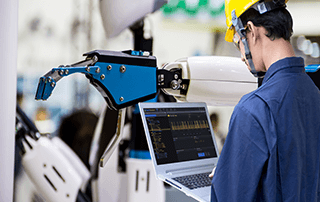Vibration monitoring systems, while a vital part of assessing the functionality of equipment, can be costly and inaccurate when implemented incorrectly. In industrial settings that rely on precision to run smoothly, equipment anomalies can severely impact operational performance. With the help of vibration sensors, these anomalies can be spotted and addressed – so the accuracy of a vibration monitoring system is just as important as the equipment itself.

The process for vibration analysis starts with establishing a baseline. When using industrial sensors to monitor the condition of a piece of equipment, it’s necessary to find the amount of vibration that it produces when in desirable condition. From there, the industrial sensors and instruments can recognize any deviation from the baseline.
Signal characteristics inform the condition of a piece of equipment and can be divided into three sections – synchronous, asynchronous, and sub-synchronous. Synchronous vibration peaks are typically tied to physical characteristics of the system while asynchronous vibration peaks can correlate to periodic shocks and sub-synchronous peaks are caused by anomalies occurring below the main reading. These signal characteristics are collected by vibration monitoring systems and translated into signals of anomalies such as defects, loose parts, or turbulence.
The problem with accuracy begins with the vibration sensor itself. Handheld vibration probes, a common way of measuring vibration, offer a few challenges for collecting accurate and useful data. These vibration sensors require measurements to be taken by hand, which requires time and leaves room for human error. Even slight differences in how the probe is held will create inconsistent readings. This lack of accuracy leads to overlooked anomalies and a decrease in performance – but there’s an alternative that can solve these issues.
Unlike handheld vibration probes, wireless vibration sensors remove human error and allow for more consistent and accurate measurements. Wireless vibration sensors remove extra shifts needed for taking measurements by hand, allow monitoring of hard to reach equipment, and significantly improve predictive maintenance programs.
Additionally, wireless vibration sensors can monitor the condition of equipment 24/7, which leads to a more direct response to anomalies. In an environment where equipment failure can severely affect production and can even be a safety hazard, immediate knowledge of anomalies is extremely important.
Wireless vibration sensors can also be programmed to reflect the importance or level of risk associated with different equipment. If a specific piece of equipment is known to need more frequent maintenance, the monitoring for that equipment can be increased. Similarly, the frequency of monitoring can be tailored to recognize significant indicators of impaired function as well as the age of a piece of equipment. Newer equipment that doesn’t require as much maintenance or focus can be monitored less than a more anomaly prone piece of older equipment. This customization in monitoring frequency enables a more efficient system of measurement.
In comparison to handheld vibration probes, wireless vibration sensors allow for a higher level of accuracy with less time and expense, which improves overall equipment efficiency.
